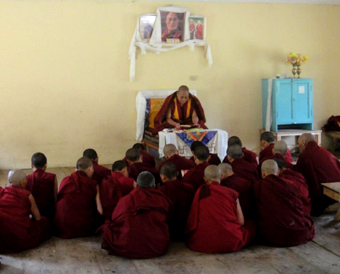Tsum Monastic Communities
Mu Gompa and Rachen Nunnery

High in the Himalayan ranges, near the majestic Ganesh Mountain, is a hidden valley called Tsum. It is said to be one of the belungs, hidden valleys that are only accessible to certain people with special merit.
Tsum is a very old Buddhist region, close to Tibet, with a long Dharma history, and blessed by meditators, such as Padmasambhava, Milarepa and many others. It is a most conducive place for practice and a special place to attain liberation in this lifetime.
The place is very quiet, no distractions, in a clean environment. The atmosphere there is such that it calms down the heart, and the mind. Naturally your mind settles down, becomes peaceful. You forget about your problems, the unnecessary troubles of the busy city life disappear, and body, speech and mind become fresh and light, with positive thoughts arising easily. That is how conducive the environment in Tsum is for meditators.
Its many small villages are clustered along the river raging downhill. Amongst the settlements are Rachen Nunnery and Mu Gompa. Rachen Nunnery and Mu gompa were established in 1936 by Dukpa Rinpoche, a lharama geshe from Tibet, who meditated in the caves dotted along the rim of the valley. His incarnation, the present Dukpa Rinpoche continued to take care of the nunnery and monastery till in 2002, when he requested Lama Zopa Rinpoche to take the nunnery and Mu gompa, further up the valley, under his care. Dukpa Rinpoche had been asked by the previous Karmapa to dedicate his life to spreading the Dharma in the Himalayas, and to establish the Nyungne practice and Mani mantra retreat. He was also dedicated to inspire the villagers to refrain from harming other sentient beings, especially the animals, by not hunting them any longer. Although his great task prevented him from spending more time at his monastery and nunnery in Tsum, still he was able to provide a true sanctuary for those who wanted to dedicate their life to the Dharma.

When Kopan Monastery was asked to take care of the two monastic communities, the monks and nuns were living in extremely dire circumstances, sleeping on the bare floor, and having very little to eat. They were mostly older sangha who had been there for many years, many of them disciples of Geshe Lama Konchok, who meditated in these mountains for more than 25 years.
The monks sent to Tsum to take over the management immediately initiated a better food supply, improved the living quarters, and started a school for the young nuns and monks.
Within a year around hundred young nuns and monks had joined the revived communities. A major building program was drawn up, with the intention of providing better living conditions to the residents while at the same time preserving the ancient culture that existed there.
Rachen Nunnery represents a great opportunity for many young women in the valley. Previously there was little choice for these women but to follow the traditional way of life of being a wife and mother, now they could join the school and study program. The nunnery has now 80 young and old nuns, meditating, praying and studying. The nunnery provides food, and medical care, and education. A qualified geshe teaches philosophy, and English and Tibetan classes are attended by all. New warm and spacious rooms, a kitchen, dining room and class rooms have been constructed in the past few years, where everybody helped in the work. The original gompa is being preserved, it is a treasure chest of old paintings and texts with a spiritually charged atmosphere. However it is is now too small, and a new gompa is being built at this moment. A resident Tibetan doctor is taking care of health problems.
Mu Gompa at 4000 m is situated on top of a foothill, in spectacular surroundings, overlooked by high white capped peaks. It is very isolated, with the next settlement several hours walk away. The wind whistles continuously through the eaves of the buildings. It is a true hermitage, and many great meditators have lived here. But live is tough here. The cold and piercing wind makes live difficult. Firewood has to be brought from far away, as mu is above the tree line. Supplies are brought in by mule caravans from neighboring Tibet.
20 monks live here under the guidance of a spiritual teacher. The young monks receive teachings in Buddhist scriptures, learn Tibetan and English, and attend general knowledge classes. The older monks, some of them living here for the past forty years, spend their time in meditation. For religious festivals the whole community goes to Rachen gompa to attend the pujas and enjoy the company of other monks and nuns.
At between 3500 to 4000 meters altitude, the winters are long and very hard, and many people will leave for lower lying areas. Most of the younger monks and nuns come to Kathmandu during the winter months, staying at Kopan Monastery and Khachoe Ghakyil Nunnery, attending classes and teachings there and enjoying the life in a warmer climate. Spending time in Kathmandu is a very welcome change: everybody uses the opportunity for pilgrimage to the holy places in the Kathmandu valley, visit family, deal with any health problems and stock up supplies for their return to the hidden valley once spring returns.

There is practically no potential income source in this remote valley. To allow the monks and nuns living there to focus on their meditation practices ands study, they need the support of the outside world. Because of the remote location and the spiritual history of the valley, a lifestyle of meditation and contemplation is still possible there. Please help to preserve this precious jewel high in the Himalayan mountains.

